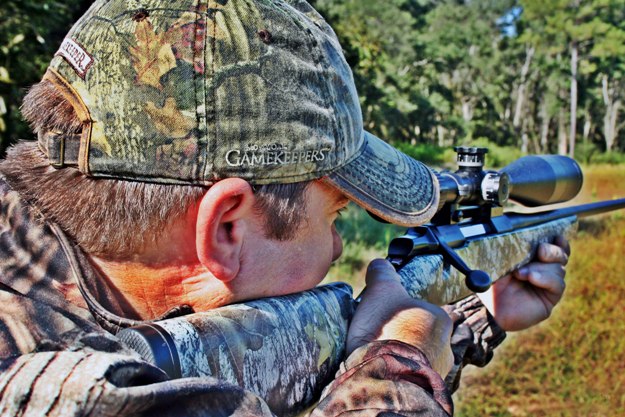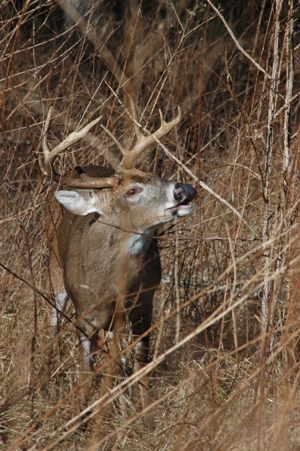
Editor’s Note: Mossy Oak Pro Lance Howard lives in Theodore, Alabama, just south of Mobile, in one of the southernmost sections of Alabama. During the Great Depression of the 1930s, when deer and turkey were nearly wiped out across Alabama, large landowners in south Alabama protected the deer and turkeys on their lands. Today these many south Alabama deer have resulted in overpopulation of the deer herd there. Howard has lived on his family’s 3,500 acre peanut and cotton farm all his life and has developed strategies for taking deer there.
One question I'm often asked is what I’m doing to keep the deer from smelling my human odor, especially since we have warm weather most of deer season. Some people say that I'm over the top in my concern about hiding or masking human odor. When I hunt, I bathe in scent-free soap, I wash my clothes in scent-free clothes wash, and I put scent-free products in my dryer. When I take my clothes out of the dryer, I put them in a scent-free bag and don’t put my hunting clothes on until I get into the woods. I also spray down with scent-free odor killer. The final step is: I use an Ozonics device over my head, when I'm hunting from a tree stand or my ground blind.
A lot of people ask me,“How effective do you think the Ozonics device is for killing human odor?” I believe it’s just another good step and a good product to use to make sure critters can’t smell you. When I'm hunting ina tree stand, I like to get up 18- to 25-feet high. I believe that hunting high helps keep your scent away from the deer. I use all the scent-eliminating products, and then I put the Ozonics device above my head. Earlier (Day 2), I said I thought one of the most important keys to successfully take deer is to never let the deer know you’re hunting them. I believe the number-one element that tells the deer you're in the woodsand where you are is human odor. I take all the steps I can to mask or kill my human odor. Even if you’ve done everything you know to do to determine which direction a buck will come from, they still may come from downwind sometimes. Whether or not I get a shot at that buck is not nearly as important as making sure that deer can’t smell me. Even though I think I’m doing everything I can to hide human odor, I'm still not going to advise anyone to go to their stand and sit with the wind at their back. I always want to hunt with the wind in my face, even though I believe I'm as scent-free as possible.
Besides hunting south Alabama, I also hunt in Texas where the weather’s really hot, and I also use this odor-eliminating system when I hunt there. On one hunt, I had an entire sounder of about 20 or 25 feral hogs come directly downwind of my stand to within 20 yards before I harvested two of them. I know for certain those hogs should have been able to smell me, if I hadn’t been using my scent-eliminating system and my Ozonics. I think hogs can smell better than deer. I felt like that was the acid test of the effectiveness of using some type of scent-elimination system.
 Our farm is several hours away from the Mobile Delta. The Mobile Delta is a big swampy estuary area where several rivers and streams come together and create a big marsh. This is also the area where Hernando de Soto landed in the mid-1500s when he first came to America. When de Soto and his men came to explore this New World, they brought domestic livestock from Spain, including hogs and cattle. The hogs and cattle roamed free in the Mobile Delta. When the early settlers wanted meat, they'd go into the woods and harvest a wild hog or a wild cow. So, we've had feral hogs in Alabama, especially in the southern part, for many, many years. However, the feral hogs were never all caught and put into pens when the fence laws were enacted back in the 1930s and 1940s. All the cattle are gone now, but the hogs have remained, and they’ve migrated up the river systems.
Our farm is several hours away from the Mobile Delta. The Mobile Delta is a big swampy estuary area where several rivers and streams come together and create a big marsh. This is also the area where Hernando de Soto landed in the mid-1500s when he first came to America. When de Soto and his men came to explore this New World, they brought domestic livestock from Spain, including hogs and cattle. The hogs and cattle roamed free in the Mobile Delta. When the early settlers wanted meat, they'd go into the woods and harvest a wild hog or a wild cow. So, we've had feral hogs in Alabama, especially in the southern part, for many, many years. However, the feral hogs were never all caught and put into pens when the fence laws were enacted back in the 1930s and 1940s. All the cattle are gone now, but the hogs have remained, and they’ve migrated up the river systems.
As hunters began to hunt the hogs in south Alabama, some of those hunters thought it would be a neat idea to trap some of those hogs and release them on hunting lands in north Alabama. Now the State of Alabama has hogs all over. However, we haven’t had a problem with feral hogs on our property. In the last 25 years, only one feral hog has been killed on our farm, and we've only seen signs of hogs twice. Hogs can compete with deer for food, and they often will kill and eat fawns. They root up crops and green fields and cause millions of dollars of damage for Alabama farmers.
Farmers a mile away from our farm have severe hog problems.We hardly can believe that those hogs haven’t come over and started eating our crops, especially our peanut fields. I think one of the reasons we haven’t had a problem with hogs is we don’t have any swampy bottoms and only a few creeks. Generally hogs have to have water to drink and to keep them cool. By wallowing in wet places, they can keep insects and parasites off them. Our farm is situated in west Mobile County where the terrain is primarily flat and very dry. That may be one reason we don’t have many hogs, and that our deer herd continues to increase.
Hogs aren’t the major problem that we see moving into our area that may affect our deer hunting. Metropolitan Mobile, Alabama, is beginning to move to the west. We’re seeing more houses and sub-developments built and more habitat being lost. So, I don’t know how long we’ll be able to have as many deer as we do because of urban encroachment. Another problem I see on the horizon is the encroachment of cogongrass. This invasive species of grass grows quickly and produces a seed head that’s carried by the wind. Cogongrass easily and quickly can take over a food plot, because deer don’t eat it. Because it covers the ground and prevents turkeys from getting to young green plants, and it doesn’t hold insects like native grass does for turkeys to feed on, we've become really concerned about the effects this grass is having on our wildlife.
To learn more about hunting, check out John E. Phillips’ new eBook and print book, “Bowhunting Deer: Mossy Oak Pros Know Bucks and Bows.” You also can download a free Kindle app that enables you to read the book on your iPad, computer or Smartphone.
For information on making jerky from your deer to provide a protein-rich snack, you can download a free book from http://johninthewild.com/free-books.






























